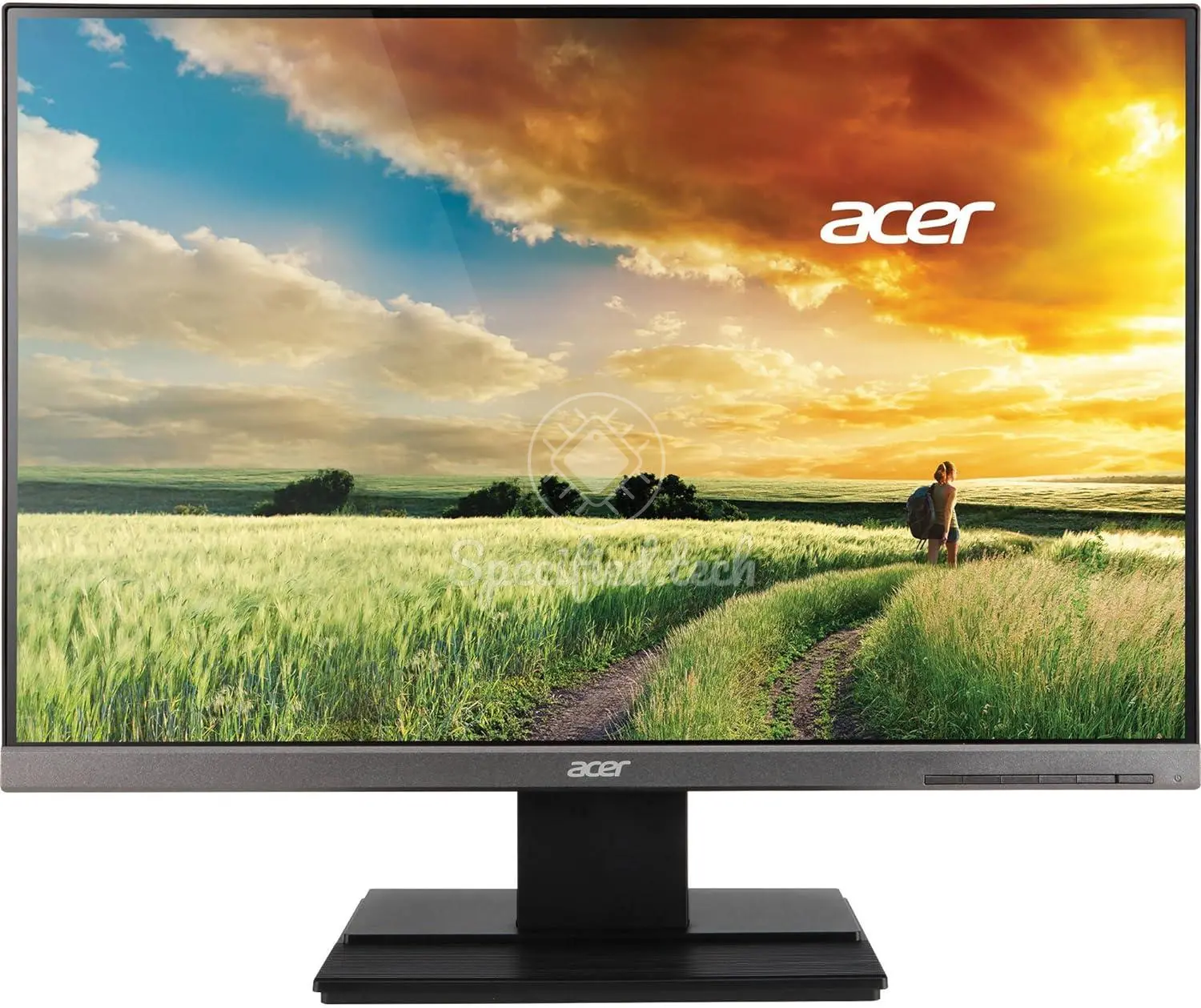
Within this article we will take a closer look at the technical specifications of the V246WL monitor from Acer. For this we will talk about all possible categories that could be relevant. To start with, we will look at the display, talk about the design and in the next section we will go into the features of the monitor. Other features such as power consumption, connectors and certifications will follow later in the text.
Display
Games, texts, videos and/or other applications can be displayed on the monitor's 24 inches ( 60.9 cm on the diagonal). Television screens and monitors usually have an aspect ratio of 16:9 (approximately 1.78:1). More rarely, computer monitors are also found with an aspect ratio of 16:10.
Ultrawidemonitors are often manufactured with an aspect ratio of 21:9 (approximately 2.34:1). They are mainly used for computer games and as an alternative to two side-by-side screens. The first devices of this type came onto the market around 2014. Against this backdrop, the monitor V246WL from Acer faces an aspect ratio of 1.778 : 1.
In addition to the aspect ratios and the specified screen diagonal, the ratio between the monitor surface and the actual display could also be relevant for some enthusiasts. This ratio represents the general relationship between non-display and display. In other words: Approximately 83.7 % of the front surface of the monitor consists of the display, while the remaining percent consists of screen edges and is not suitable for image reproduction. If you want to place several monitors next to each other, you should make sure you choose models with the narrowest possible edges. The display is a IPS panel. The panel has a resolution of 1920 x 1080 px. The pixel density is 91 ppi. The pixel pitch is 0.277 mm. The continuous possible brightness specified by the manufacturer Acer is 300 nt. The panel is illuminated by W-LED. The built-in panel ensures stable color reproduction of the image, even at deviating viewing angles, by means of its 178 ° (horizontal) viewing angle. Acer promises stable color reproduction moreover within a 178 ° vertical angle. The refresh rate is horizontally seen at the V246WL 30 khz to 80 khz. Vertically, however, the image renews at a minimum rate of 55 hz up to 75 hz. The minimum response time of the monitor is ms. The average response time of the monitor is about ms. The display panel is Anti-glare/Matte (3H).
Color representation
The panel has a bit depth of 8 per color channel, but what does that mean? The number of bits determines how many colors can be encoded for the individual pixels of the display. For an 8-bit panel, for example, this is 256 different colors (2^8 = 256). However, since we usually display three different colors per pixel at the same time, in theory about 16 million (256^3) different colors are possible by mixing the three pixels. A 10-bit panel could even display a billion colors. According to the manufacturer, the coverage of the NTSC 1953 color space is 72 %.
Contrast ratio
Contrast ratio is a common measurement used to represent the maximum relative differences in brightness between black and white. It describes the ability of a screen or projector to produce a high-contrast image and is the quotient of the maximum and minimum displayable luminance. The higher the values are away from each other, the stronger the quantitatively seen difference between black and white is set up, which in turn results in an improved image quality. This monitor from Acer has a static contrast ratio of 1000 : 1 , according to the manufacturer. In contrast to the static contrast ratio, the dynamic contrast ratio changes the brightness of the panel itself in addition to the difference measurement from black to white. In addition to the difference between the brightest and the darkest pixel, the backlight is thus changed. Since the brightness of the panel may not be able to be adjusted exactly to a single pixel, a so-called halo effect is possible. The value of 100000000 : 1 of dynamic contrast ratio for the monitor V246WL cannot provide any information about the severity of the halo effect here. Therefore, it is more useful to compare the static contrast ratio.
HDR
The monitor supports all HDR modes listed here:
screen design
The monitor has a width of 53.3 cm without its attached stand/stand. The height is dimensioned at about 35.5 cm , while the for the depth of the monitor should be kept free at about 5.3 cm.
The size of the monitor (stand included) is 43.7 x 53.3 x 20.7 cm (HxWxD). If you want to place the monitor on a table or even transport it, you should expect a weight of 4.1 kg with the stand screwed in. The monitor V246WL without the stand weighs 3.6 kg. This weight reduction should be taken into account for wall or arm mounting, since monitor arms have a maximum load capacity. Speaking of weight without a stand and thus wall or table mounts. The monitor supports a Vesa mounting.
Rotate, tilt and swivel
The monitor from Acer cannot be rotated. The monitor cannot be swiveled. This feature could be retrofitted with a third-party stand. The monitor V246WL can be tilted. The angle of inclination to the rear is 25. The monitor can be tilted forward by 5 degree.
Ports
The monitor can be connected via 1 VGA ports.
camera
This monitor does not have a camera.
Features
- The display/monitor supports Frame Rate Compensation.
Power consumption
On average, the monitor consumes approximately 19.5 w. In standby mode, the device consumes approximately 0.45 w. When switched off, on the other hand, the monitor consumes only 0.35 w. The monitor can be operated on a 110v power supply. The monitor can be operated on a 220v power supply. The power grid has to supply a frequency of 50 hz to 60 hz.
Further information
- 100x100

